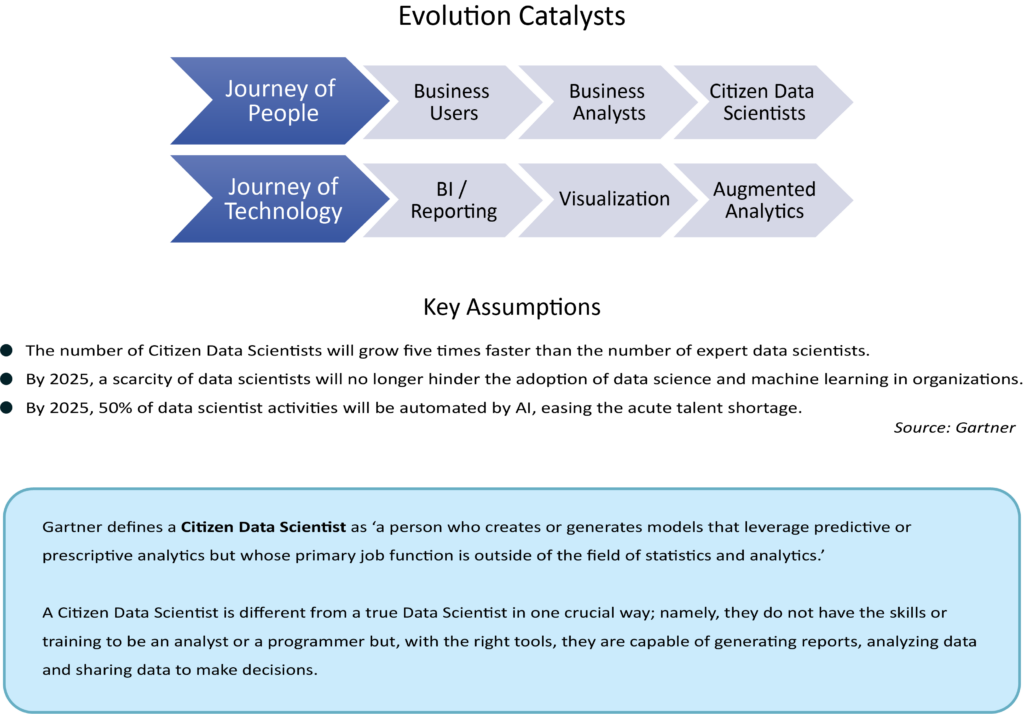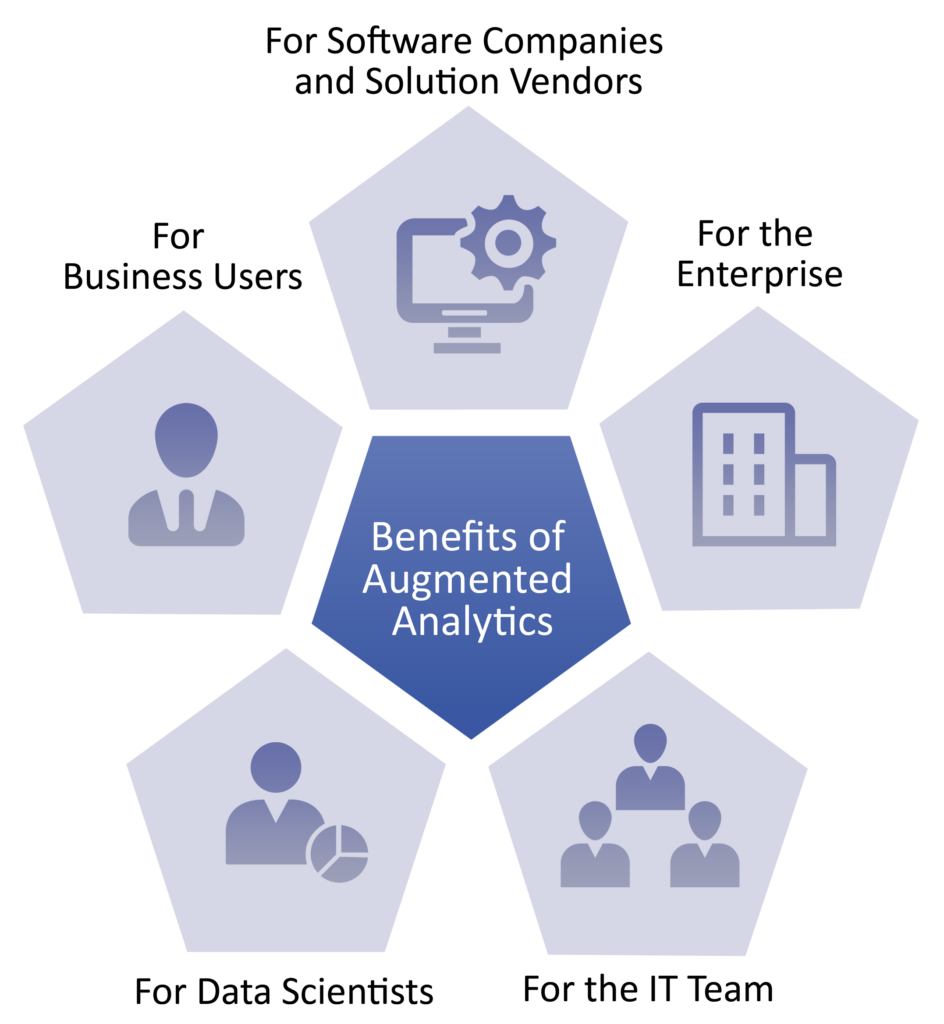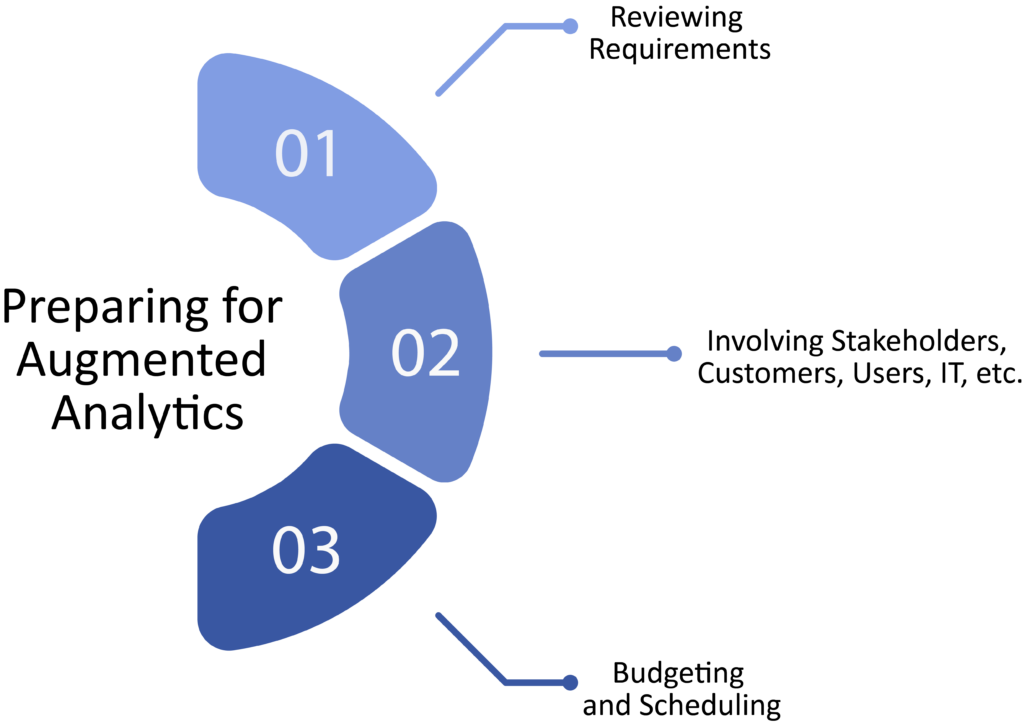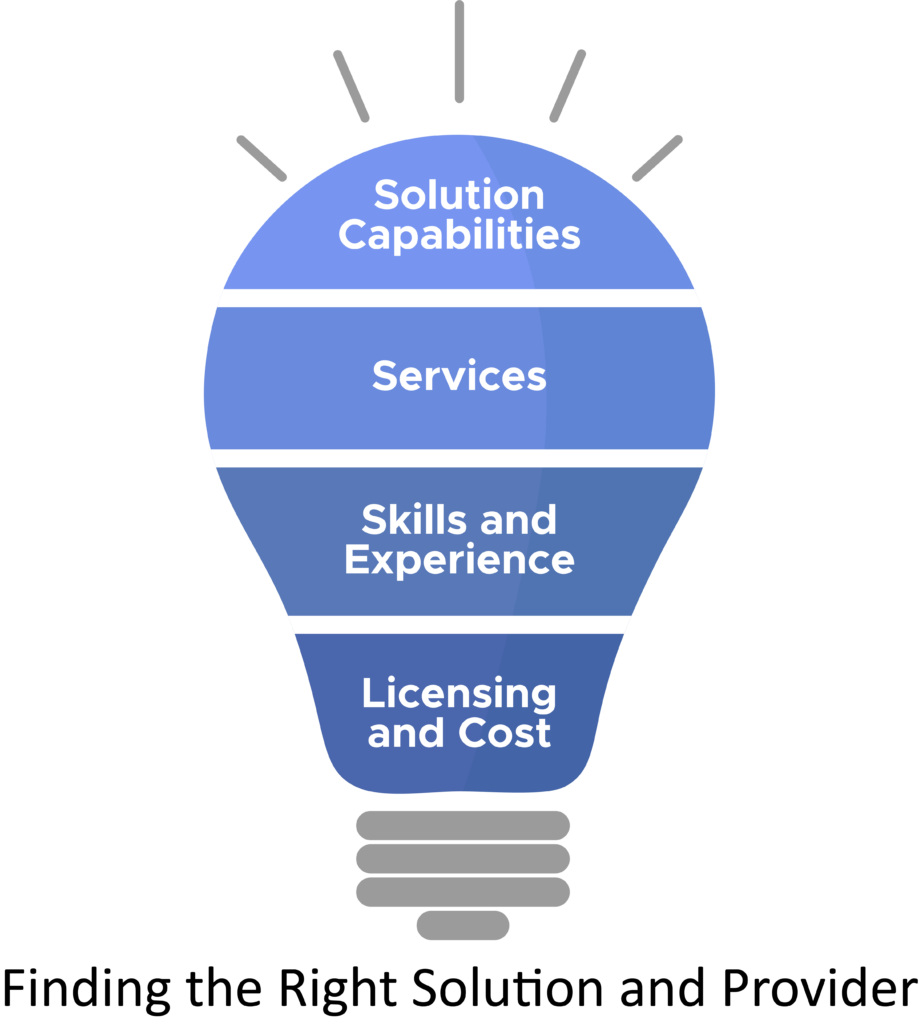Augmented Analytics Guide: What is Augmented Analytics, and How Can Self-Service Analytics Help Your Business
Perhaps your business is considering an augmented analytics solution, or your enterprise already has some version of business intelligence or analytics and it wishes to upgrade or transition to a more beneficial solution. Maybe you just want to understand the analytics solution market better. Whatever the case, this article will help you gather information about the topic of augmented analytics and, if you are looking for a solution, it will help you organize your thoughts and include the critical considerations and factors to ensure project success.
Before we dive into the details, let’s start with a definition.
What is Augmented Analytics?
The world renowned technology research firm, Gartner, Defines Augmented Analytics in this way.
‘Augmented analytics is the use of enabling technologies such as machine learning and AI to assist with data preparation, insight generation and insight explanation to augment how people explore and analyze data in analytics and BI platforms. It also augments the expert and citizen data scientists by automating many aspects of data science, machine learning, and AI model development, management and deployment.’
If you are not already familiar with the term, ‘Citizen Data Scientist,’ you might want a definition of that term as well. Citizen Data Scientists are business users who enjoy data democratization and improved data literacy by adopting analytics tools that are easy to use and allow users with average technical skills to participate in sophisticated analytics and to use that analysis to make day-to-day decisions.
As Springboard notes, ‘Augmented Analytics is an example of human machine interaction in the data science field.’
The augmented analytics solution is typically supported by natural language processing (NLP) to support users in the query and results process. As with Google and other NLP interfaces, augmented analytics allows the user to ask a question using simple human language and receive results in the same way, so the business user does not have to write code, create complex SQL queries or wait for the in-house IT team or data scientist team to create reports.
The augmented analytics search engine allows users to factor in several variables, e.g., a list of sales team members, a time period or range, a category of products or items etc. So, you can ask, ‘Who sold the most bakery items in the Southwest region from September through November of 2022,’ and you will receive your results and can visualize your data in a way that makes sense to you and to your team.
‘Your business can benefit from a full suite of services to a) help refine requirements and produce a roadmap for implementation and roll-out, b) provide support for training needs or project presentation, c) provide 24/7 support for products and technology, d) plan for and support upgrades.’
The definition of Augmented Analytics can be broad, and all augmented analytics solutions are not equal in capabilities, features and functions. In the section entitled, ‘Assessing Augmented Analytics Companies,’ we provide a list of features, services and skills you will want to include in your project requirements.
For your business purposes, it is important that you have a clear picture of the augmented analytics definition, so that you, your management team, your IT team and your business users are all on the same page when it comes to your expectations for this product and service suite and for resulting benefits you can expect.
How Has Analytics Evolved?
Just as with any other software or technology evolution, the analytics solution market has changed. As new technologies and techniques emerge, the wise analytics solution provider will leverage these new technologies to improve usability and create new features and functionality.

The Inception of Business Intelligence (BI) Tools: Historically, the business intelligence solution market was limited to systems and solutions to support data scientists and IT teams. These systems required users to create SQL queries and/or write code to gather and analyze data from multiple systems across the enterprise. In the early days, there was no one solution for data scientists and IT teams to use. Rather, they were writing queries to pull information and derive data from systems without a simple interface.
The Inception of Self-Serve Analytics: When the self-serve analytics market emerged, the traditional business intelligence (BI) tools supported business users with features like key performance indicators (KPIs) to establish and measure results using objective metrics, and with flexible report formats that enabled data visualization in a way that was meaningful to users. What is self-service analytics? We should probably explain before we move on.
Here is a brief definition of self-service analytics: Self-Serve Analytics is a solution that is designed to support business users who do not have data science or IT skills. When these tools were introduced to the market, they provided support for the first iteration of a Citizen Data Scientist approach.
Modern BI and Analytics: The evolution of business intelligence tools and analytics approaches saw the introduction of specific tools and features, designed for business users in a self-serve environment. The question, ‘what is self-service analytics,’ varied among enterprises, with some businesses limiting the use of these tools to power users and those team members who had a natural curiosity about analytics. Solution capabilities included Self-Serve Data Preparation, Smart Data Visualization and Predictive Analytics for forecasting, etc.
Augmented Analytics Explained: As self-serve augmented analytics began to evolve, new tools and techniques were added, and business users now enjoy the expanded capabilities of predictive analytics. Augmented Analytics vs Predictive Analytics is not really a question. The real question is how do you integrate predictive analytics into the world of the business user to allow them to test theories, prototype and use sophisticated algorithms and analytical techniques in an environment that can still be considered ‘self-serve,’ and ‘user friendly?’ With the right self-serve solution, users can leverage techniques like time series forecasting (Holt-Winters, ARIMA and ARIMAX), Regression techniques (simple and multiple linear regression), Classification (naïve-bayes, decision tree, K-nearest neighbor, binary logistic regression), Association including frequent pattern mining, Correlation including Spearman and Karl Pearson, Clustering including K Means and hierarchical, hypothesis testing (one-way Anova, Paired T-test, Chi-Squared Test) and Descriptive Statistics (Mean, Median, Mode, etc.). Additional tools like PMML Integration to provide simple language interpretation of models and enable predictions using single and multiple test records with user-friendly graphical user interface (GUI) or Web services API, Anomaly Monitoring and Alerts and Sentiment Analysis add to the suite of techniques to further enable self-serve analytics for the average business users.
Augmented Analytics Today and In the Future: Today, augmented analytics has changed in a number of ways. The foundation of the technology now provides better performance with low-code and no-code options to improve scalability and reduce the size of the solution for easier implementation, use and upgrade. Numerous publications, like BuiltIn and Berkeley write about the expansion of artificial intelligence (AI) in analytics. As AI advances and its use becomes more dependable it will find its way into more analytical solutions and its incorporation means more user-friendly tools for business users with more capabilities and functionality.
Why is Augmented Analytics Important?
Gartner Core Data and Analytics Predictions state that, ‘70% of organizations will rigorously track data quality levels via metrics, increasing data quality by 60% to significantly reduce operational risks and costs,’ and that ‘90% of the world’s top 500 companies will have converged analytics governance into broader data and analytics governance initiatives,’ and lastly, ‘60% of organizations will leverage machine-learning-enabled data quality technology for suggestions to reduce manual tasks for data quality improvement.’
So, what does all this mean to your business? Why is augmented analytics an important factor in your success? The typical business will find it difficult to achieve approval for a new software solution. Executives tend to look at technology from the lens of expense and time, and your team is probably no different. If you are to gain approval for a new augmented analytics solution or an upgrade of your existing system, you will need to focus on the importance of the solution to your enterprise, both at the organizational level and for its business users, stakeholders, customers, etc.
Here are a few reasons you should consider augmented analytics for your enterprise:
- If your business users have access to augmented analytics, your business analysts, data scientists and IT team can focus on strategic issues and projects, without the burden of day-to-day analytical requests.
- Accessible augmented analytics, allows you to transition your business users to the Citizen Data Scientist role to make better decisions, more quickly.
- Users can replace guesswork and opinion with fact-based presentations and recommendations for more measurable analysis of trends, product pricing, financial investment, manufacturing and production and all other business factors.
It is not always easy to convince the management team of the wisdom of a new investment, but it is important to understand that the market for augmented analytics is evolving and that your competition is already on board and using these tools to engage with customers, create new products and solve problems before they negatively impact the bottom line.
Now that we have discussed the importance of considering these tools to improve your company results and support your business users, let’s take a closer look at the real benefits of augmented analytics.
The Benefits of Augmented Analytics
Whether you are an IT consultant, an in-house IT professional, a middle manager or a senior executive, it is important to monitor the progress of business analytics and the related technology. Every business needs to understand how these solutions can and will affect users, processes and workflow. The Benefits of Self Service Analytics are too numerous to mention. But we have highlighted some of the primary advantages here.

Benefits for the Enterprise
Augmented analytics can be a real benefit to the organization and can improve your competitive advantage by helping you to strategize and make timely, confident operational decisions without wasting time or resources. You can also incorporate augmented analytics into your customer-facing apps and solutions to improve customer satisfaction and provide additional features that will add competitive value to your services. Augmented analytics can help the business to improve revenue and to discover product and service opportunities and gain insight into issues to resolve problems before they create risk. Unscrambl highlights a few of the ways major businesses have used analytics to help improve competitive positioning and to solve problems. One such example focuses on Coca-Cola. The business improved its click-through rate on social media by using augmented analytics to analyze and improve its existing social media presence. FreeCodeCamp reports success in augmented analytics across many industries and business functions, including Retail, Manufacturing, Healthcare, and Financial Services.
Benefits for the IT Team
Self-Service analytics best practices include a roll-out to business users and that requires a new perspective on data governance and on user access. But the IT team does not have to tackle these issues alone. With the right augmented analytics solution and provider services, your IT team can review existing technology, hardware, network and security issues and work with the IT consulting partner to establish an appropriate environment. Once this is complete, the IT team will be in a position to focus on strategic issues, rather than fielding day-to-day report and analytical requests from business users and managers. The new analytics foundation provides a streamlined, scalable solution that integrates data from disparate data sources across the enterprise and allows the IT team to better monitor and manage user access and analytics across the enterprise.
Benefits for Data Scientists
Data Scientists and business analysts can leverage the new augmented analytics solution to prepare and analyze data across the enterprise without having to write SQL queries. This approach allows the analyst and data scientist community to focus on strategic issues and to work with business users to refine analytics created by the team when the day-to-day analysis must be further curated and prepared for presentation to senior executives. The professional analytical resource community can spend more time on high-value issues and analytics and less time on team member requests and questions.
Benefits for Business Users
Giving your team the right tools and a simple way to manage the overwhelming flow of data is crucial to business success. This approach makes every team member more valuable to your organization and allows them to perform tasks more quickly and to gain true insight into data without the assistance of a data scientist or an IT team member. Augmented analytics examples are prominent in the press today. No matter the role of the business user, the enterprise can transition the team to a Citizen Data Scientist role and thereby improve productivity and decision-making. For the business user, the transition can significantly increase their career visibility and success by providing them with meaningful information, so they can present data, collaborate and share, and make suggestions and recommendations for process, pricing, product, and service changes and improvements. Augmented analytics can reduce frustration and re-work, and make your business users happy.
Benefits for Software Companies and Solution Vendors
Self Service Analytics best practices include the addition of Embedded Business Intelligence (BI) and the creation of long-term IT Partnerships between software vendors and businesses that sell and support apps and solutions. Adding augmented analytics to your existing software product provides real value to your customers and improves your competitive positioning in your market. IT consultants, system integrators, ISVs, and resellers can benefit from adding self-serve analytics to their apps and software by offering unique solutions without a significant investment. You can add predictive analytics and natural language processing (NLP) capabilities to your products and services to achieve rapid results and ensure customer satisfaction by working with skilled development and support staff to bring this integrated capability to your organization.
Adopting Augmented Analytics
Before you embark on your journey to implement augmented analytics software, or to upgrade your existing business intelligence or analytics approach, you will need to plan carefully for success.

Reviewing Requirements
Work with your IT team to review your existing infrastructure, network, hardware, and data storage and the landscape of solutions and apps that will require integration with the augmented analytics platform. Be sure you have a thorough understanding of your business user community, their existing technical skills and the issues they are likely to present when you suggest a new analytics solution. This understanding will allow you to better communicate with your team, and to choose the right solution to address your needs. Establish a common understanding of your goals. What do you want to achieve by implementing an augmented analytics solution? What problems will it solve? What opportunities does it present?
Involving Stakeholders, Customers, Users, IT, etc.
Do not work in a vacuum! You cannot present a comprehensive solution and set metrics for success if you don’t understand the issues. Involve your business users, management team, IT team and stakeholders (suppliers, customers, etc.) in the discussion. You will gain a much better understanding of how people work today, and you can anticipate the questions and issues, and even identify the numerous opportunities inherent in the prospective interaction of these communities with the analytics solution and its potential. Develop Self Service analytics examples and use cases to help business users understand how this new initiative can make their jobs easier.
Budgeting and Scheduling
Self-Serve analytics does not have to be costly, but it can be if you a) do not have the right understanding of your requirements and b) if you don’t choose the right solution and the right vendor. Work with your team and the IT partner to develop a realistic budget and schedule (don’t underestimate or overestimate). Self Service Analytics can save you money in the long-term, so when you develop your budget and your presentation, be sure to offset the cost of the new system and implementation with the overall savings you expect. Decide whether you will implement the self-service analytics solution across the enterprise, or start small in one department or division and learn from that implementation. Decide whether it is time to upgrade or change technology or equipment while you are implementing the new solution. Perhaps you want to shift from a data warehouse to cloud storage. If you choose the right self service data analytics tools with the right self service analytics capabilities, you can avoid a cumbersome, long training schedule. Be realistic about your implementation expectations and include budgeting and time for champions, power users and support to ensure appropriate user adoption.
‘All augmented analytics solutions are not equal in capabilities, features and functions.’
Assessing Augmented Analytics Companies
In this augmented analytics guide, we have talked about the meaning and importance of augmented analytics, and its evolution, as well as the benefits of taking this approach and the factors you must include as you prepare to gain project approval, introduce the concept to your organization and plan for solution selection and implementation.
In this final section, we look at the primary considerations you must include as you search for, interview and select Augmented Analytics tools and self service analytics providers.

Solution Capabilities
The best Augmented Analytics solutions provide a) sophisticated features, b) an Easy-To-Use User Interface and navigation that is suitable for all team members, c) scalable Technology and a high-performance environment that is easy to manage and upgrade.
Look for a full suite of Products and modules, including Self-Serve Data Preparation, Assisted Predictive Modeling, Smart Data Visualization, and a product that is built on a natural language processing (NLP) foundation for easy NLP searching. The augmented analytics market is large, and there are many products available. Additional features that provide advanced analytical algorithms and techniques will help your users gain data literacy and provide data democratization across the enterprise by producing targeted, insightful results without the need for advanced skills. Look for products that include Sentiment Analysis, Key Influencer Analytics, and Anomaly Monitoring, and be sure that the vendor you select offers Mobile BI so your users can take the app on the road and work out of the office to improve productivity and collaboration.
Gartner predicts that ‘more than 50% of all data analysis by deep neural networks (DNNs) will be at the point of capture in an edge system.’ AI is transforming data management and the automation of tasks and analytics is no exception. Look for AI augmented analytics that is designed to leverage the current and future capabilities of AI without risk or overreach.
Lastly, while the back-end and foundation of a product may not seem exciting, this aspect of the solution drives how well the system will perform, and its scalability, its capacity for integration and incorporating embedded BI with integration APIs, and other factors.
Develop your requirements and monitor and manage the list of needs as you discover new issues or identify possibilities. Include a detailed list of product capabilities in your Request for Proposal (RFP) and your interview and demo process, so that you know you are getting what you need without expensive, time-consuming customization.
Services
When you select an augmented analytics solution, don’t forget to look at the support and services that accompany this solution. Your business can benefit from a full suite of services to a) help refine requirements and produce a roadmap for implementation and roll-out, b) provide support for training needs or project presentation, c) provide 24/7 support for products and technology, d) plan for and support upgrades.
Assuming your organization wishes to transition its business users to the Citizen Data Scientist role, your business will want to engage an IT consulting partner with a complete understanding of the Citizen Data Scientist Role and the ability to help you with training.
Skills and Experience
Your solution provider and partner should have a deep, broad team of professionals, focused on technology and on soft skills. Reporting, communication, support and market and domain understanding are key, as is a comprehensive understanding of the augmented analytics market and data science and analytical techniques, as well as data management and data governance and data security issues. Look for a partner with a proven record of success and a partnership approach that will support your enterprise now and in the future.
Licensing and Cost
Cost is always a concern to a management team and, while you want to get every feature you need, you don’t want to pay a premium price. Review the prospective vendor pricing and licensing models and be sure that the costs include what you need. A reputable vendor will provide transparent pricing. Does the vendor include Mobile BI access in the licensing fees or is this extra? How many users does the license support? Is the solution out-of-the-box or does it require customization?
This article provides a significant foundation for understanding augmented analytics and beginning your journey to plan, select and implement an augmented analytics solution that will help you achieve your goals, improve data democratization and data literacy and transition your business users to Citizen Data Scientists.
Get in touch with us!
Contact Us to find out how augmented analytics Technology can support your enterprise, and ensure analytical clarity and results. Discover the next level of self-serve analytics with Augmented Analytics and explore the features and modules to see how your business can use analytics to achieve its goals.



